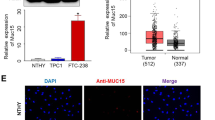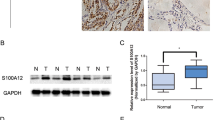Abstract
Clinical evidence indicates that high periostin expression correlates with aggressive phenotype in thyroid carcinoma. However, the biological roles of periostin in thyroid carcinoma development and progression are still unclear. In this study, we explored the effects of periostin silencing on thyroid carcinoma cell growth, invasion, and tumorigenesis. We also studied the impact of periostin on the activation of phosphoinositide 3-kinase (PI3-K)/Akt signaling, which is involved in the pathogenesis of thyroid carcinoma. It was found that downregulation of periostin significantly inhibited the proliferation, colony formation, and invasion in both FTC-133 and BCPAP thyroid carcinoma cells. In vivo tumorigenic studies confirmed that periostin depletion retarded the growth of subcutaneous FTC-133 xenograft tumors, which was coupled with a significant decline in the percentage of Ki-67-positive proliferating cells. Western blot analysis demonstrated that periostin downregulation caused a marked inhibition of thyroid stimulating hormone receptor (TSHR) expression and Akt phosphorylation in FTC-133 and BCPAP cells. Co-expression of constitutively active Akt (CA-Akt) significantly reversed periostin-mediated downregulation of TSHR. Most importantly, overexpression of TSHR or CA-Akt rescued FTC-133 cells from periostin-induced growth and invasion suppression. Collectively, periostin regulates thyroid carcinoma growth and progression via the Akt/TSHR axis and represents a promising therapeutic target for this malignancy.





Similar content being viewed by others
References
Bai Y, Kakudo K, Nakamura M, Ozaki T, Li Y, Liu Z, Mori I, Miyauchi A, Zhou G (2009) Loss of cellular polarity/cohesiveness in the invasive front of papillary thyroid carcinoma and periostin expression. Cancer Lett 281:188–195
Cha YJ, Koo JS (2016) Next-generation sequencing in thyroid cancer. J Trans Med 14:322
Davies TF, Yin X, Latif R (2010) The genetics of the thyroid stimulating hormone receptor: history and relevance. Thyroid 20:727–736
Eng OS, Grant SB, Weissler J, Simon M, Roychowdhury S, Davidov T, Trooskin SZ (2016) Operative bed recurrence of thyroid cancer: utility of a preoperative needle localization technique. Gland Surg 5:571–575
Hong S, Yu S, Li J, Yin Y, Liu Y, Zhang Q, Guan H, Li Y, Xiao H (2016) MiR-20b displays tumor-suppressor functions in papillary thyroid carcinoma by regulating the MAPK/ERK signaling pathway. Thyroid 26:1733–1743
Ishiba T, Nagahara M, Nakagawa T, Sato T, Ishikawa T, Uetake H, Sugihara K, Miki Y, Nakanishi A (2014) Periostin suppression induces decorin secretion leading to reduced breast cancer cell motility and invasion. Sci Rep 4:7069
Kleinau G, Worth CL, Kreuchwig A, Biebermann H, Marcinkowski P, Scheerer P, Krause G (2017) Structural-functional features of the thyrotropin receptor: a class A G-protein-coupled receptor at work. Front Endocrinol (Lausanne) 8:86
Kohn AD, Takeuchi F, Roth RA (1996) Akt, a pleckstrin homology domain containing kinase, is activated primarily by phosphorylation. J Biol Chem 271:21920–21926
Landré V, Antonov A, Knight R, Melino G (2016) p73 promotes glioblastoma cell invasion by directly activating POSTN (periostin) expression. Oncotarget 7:11785–11802
Lim ST, Jeon YW, Suh YJ (2016) The prognostic values of preoperative tumor volume and tumor diameter in T1N0 papillary thyroid cancer. Cancer Res Treat. doi:10.4143/crt.2016.325
Mainetti LE, Rico MJ, Fernández-Zenobi MV, Perroud HA, Roggero EA, Rozados VR, Scharovsky OG (2013) Therapeutic efficacy of metronomic chemotherapy with cyclophosphamide and doxorubicin on murine mammary adenocarcinomas. Ann Oncol 24:2310–2316
Miao X, Jia L, Zhou H, Song X, Zhou M, Xu J, Zhao L, Feng X, Zhao Y (2016) miR-4299 mediates the invasive properties and tumorigenicity of human follicular thyroid carcinoma by targeting ST6GALNAC4. IUBMB Life 68:136–144
Naik PK, Bozyk PD, Bentley JK, Popova AP, Birch CM, Wilke CA, Fry CD, White ES, Sisson TH, Tayob N, Carnemolla B, Orecchia P, Flaherty KR, Hershenson MB, Murray S, Martinez FJ, Moore BB, COMET Investigators (2012) Periostin promotes fibrosis and predicts progression in patients with idiopathic pulmonary fibrosis. Am J Physiol Lung Cell Mol Physiol 303:L1046–L1056
Nozhat Z, Hedayati M (2016) PI3 K/AKT pathway and its mediators in thyroid carcinomas. Mol Diagn Ther 20:13–26
Nuzzo PV, Rubagotti A, Zinoli L, Salvi S, Boccardo S, Boccardo F (2016) The prognostic value of stromal and epithelial periostin expression in human breast cancer: correlation with clinical pathological features and mortality outcome. BMC Cancer 16:95
Patel PN, Yu XM, Jaskula-Sztul R, Chen H (2014) Hesperetin activates the Notch1 signaling cascade, causes apoptosis, and induces cellular differentiation in anaplastic thyroid cancer. Ann Surg Oncol 21:S497–S504
Puppin C, Fabbro D, Dima M, Di Loreto C, Puxeddu E, Filetti S, Russo D, Damante G (2008) High periostin expression correlates with aggressiveness in papillary thyroid carcinomas. J Endocrinol 197:401–408
Qin X, Yan M, Zhang J, Wang X, Shen Z, Lv Z, Li Z, Wei W, Chen W (2016) TGFβ3-mediated induction of periostin facilitates head and neck cancer growth and is associated with metastasis. Sci Rep 6:20587
Rowe CW, Paul JW, Gedye C, Tolosa JM, Bendinelli C, McGrath S, Smith R (2017) Targeting the TSH receptor in thyroid cancer. Endocr Relat Cancer 24:R191–R202
Shirley LA, McCarty S, Yang MC, Saji M, Zhang X, Phay J, Ringel MD, Chen CS (2016) Integrin-linked kinase affects signaling pathways and migration in thyroid cancer cells and is a potential therapeutic target. Surgery 159:163–170
Silvers CR, Liu YR, Wu CH, Miyamoto H, Messing EM, Lee YF (2016) Identification of extracellular vesicle-borne periostin as a feature of muscle-invasive bladder cancer. Oncotarget 7:23335–23345
Wang SC, Chai DS, Chen CB, Wang ZY, Wang L (2015) HPIP promotes thyroid cancer cell growth, migration and EMT through activating PI3 K/AKT signaling pathway. Biomed Pharmacother 75:33–39
Xiao ZM, Wang XY, Wang AM (2015) Periostin induces chemoresistance in colon cancer cells through activation of the PI3 K/Akt/survivin pathway. Biotechnol Appl Biochem 62:401–406
Xie X, Shi X, Guan H, Guo Q, Fan C, Dong W, Wang G, Li F, Shan Z, Cao L, Teng W (2017) P21-activated kinase 4 involves TSH induced papillary thyroid cancer cell proliferation. Oncotarget 8:24882–24891
Xu X, Zheng Q, Zhang Z, Zhang X, Liu R, Liu P (2015) Periostin enhances migration, invasion, and adhesion of human endometrial stromal cells through integrin-linked kinase 1/Akt signaling pathway. Reprod Sci 22:1098–1106
Xu X, Chang W, Yuan J, Han X, Tan X, Ding Y, Luo Y, Cai H, Liu Y, Gao X, Liu Q, Yu Y, Du Y, Wang H, Ma L, Wang J, Chen K, Ding Y, Fu C, Cao G (2016) Periostin expression in intra-tumoral stromal cells is prognostic and predictive for colorectal carcinoma via creating a cancer-supportive niche. Oncotarget 7:798–813
Zheng H, Wang M, Jiang L, Chu H, Hu J, Ning J, Li B, Wang D, Xu J (2016) BRAF-activated long noncoding RNA modulates papillary thyroid carcinoma cell proliferation through regulating thyroid stimulating hormone receptor. Cancer Res Treat 48:698–707
Zhong Z, Hu Z, Jiang Y, Sun R, Chen X, Chu H, Zeng M, Sun C (2016) Interleukin-11 promotes epithelial-mesenchymal transition in anaplastic thyroid carcinoma cells through PI3 K/Akt/GSK3β signaling pathway activation. Oncotarget 7:59652–59663
Zhou W, Ke SQ, Huang Z, Flavahan W, Fang X, Paul J, Wu L, Sloan AE, McLendon RE, Li X, Rich JN, Bao S (2015) Periostin secreted by glioblastoma stem cells recruits M2 tumour-associated macrophages and promotes malignant growth. Nat Cell Biol 17:170–182
Author information
Authors and Affiliations
Corresponding author
Rights and permissions
About this article
Cite this article
Wang, M., Gui, C., Qiu, S. et al. Periostin silencing suppresses the aggressive phenotype of thyroid carcinoma cells by suppressing the Akt/thyroid stimulating hormone receptor axis. Cytotechnology 70, 275–284 (2018). https://doi.org/10.1007/s10616-017-0141-0
Received:
Accepted:
Published:
Issue Date:
DOI: https://doi.org/10.1007/s10616-017-0141-0




